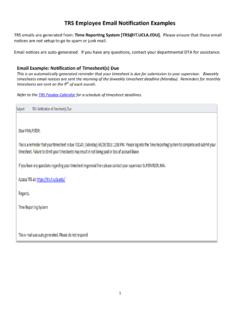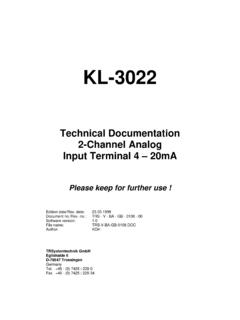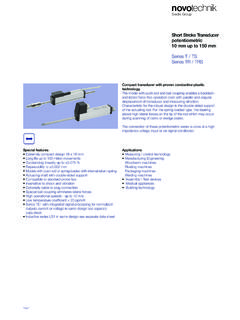Transcription of Taxable REIT Subsidiaries
1 114114by Thornton MathesonTaxable REIT Subsidiaries : Analysis of the First Year'sReturns, Tax Year 2001 Thornton Matheson is a financial economist with theTreasury Department s Office of Tax Real Estate Investment Trust (REIT)Modernization Act, Part II, Subpart A ofPublic Law 106-170, the Ticket to Work andWork Incentives Improvement Act, enacted onDecember 17, 1999, created the Taxable REIT subsidiary (TRS), which allows a REIT to offer amore complete range of services to its tenantswithout jeopardizing its status as a REIT. The REITM odernization Act (RMA) also denied tax deductionsfor interest on loans from parent REIT s to TRS s incases of excessive leverage [1].The RMA mandated that [t]he Secretary of theTreasury shall conduct a study to determine howmany Taxable REIT Subsidiaries are in existence andthe aggregate amount of taxes paid by such subsid-iaries and submit its findings in a report to Congress[2].
2 This article was written in fulfillment of thatmandate and, more generally, to examine the newentities fiscal 2001, the year in which the RMA took effect,480 firms filed Form 8875, Taxable REIT SubsidiaryElection. Of these, 404 filed Form 1120, Cor-porate Income Tax Return, and paid $ million intaxes for 2001 [3]. Of these TRS s, 154 were newlyestablished entities and the remainder pre-existingentities. Although TRS s are highly leveraged as agroup, with approximately one third of firms showingnegative equity on their balance sheets, loans fromparent REIT s to TRS s do not appear to be preva-lent. Fewer than 8 percent of TRS s have loansfrom shareholders, and such loans account for lessthan 4 percent of total TRS debt. TRS s that dohave loans from shareholders tend to be more highlyleveraged than other TRS s and have negative totalequity as a by Congress in 1960, REIT s provide avehicle for investment in real estate.
3 As long as anentity otherwise qualifies as a REIT and distributes atleast 90 percent of its income to investors as divi-dends, those dividends are deducted in computing theREIT s Taxable income[4]. Two income tests ensurethat REIT s are used predominantly to invest pas-sively in real estate: (1) at least 95 percent of aREIT s income must be derived from passive financial investments, including rents, dividends,interest, and capital gains, as opposed to active income from business activities; and (2) at least 75percent of a REIT s income must be derived fromreal estate sources including rents, mortgages, andcapital gains on real s are restricted in terms of the kinds ofservices they can provide their tenants. Specifically,a REIT may provide customary real estate ser-vices to its tenants, but providing more than a deminimis amount of impermissible services (for ex-ample, housekeeping services) at a particular prop-erty prevents rents from that property from qualifyingas rents under the REIT income tests.
4 REIT sargued that the constraints placed on their activitiesby the customary services requirement preventedthem from competing effectively with non-REIT realestate REIT s were limited in the services thatthey could provide their tenants directly, before theenactment of the RMA many REIT s establishedthird-party Subsidiaries (TPS s) to provide suchservices. Since distributions to the parent REIT sfrom these Subsidiaries were dividends, the distribu-tions qualified for the 95-percent income test, butthey did not qualify for the 75-percent income addition to the 95-percent and 75-percentincome tests, REIT s must also satisfy several quar-terly diversification tests, including: 1) the securitiesof any one issuer must not constitute more than 5percent of the value of a REIT s total assets; and 2)prior to the enactment of the RMA, a REIT could nothold more than 10 percent of the voting securities ofany issuer other than another REIT [5].
5 In order tocomply with the latter test, a REIT would typicallyown only 10 percent of the voting shares of a TPS;however, it would own close to 100 percent of thevalue of nonvoting stock, preferred stock, or ensure that the subsidiary acted in the best inter-est of the REIT, the remainder of the voting sharesof the TPS were often held by the REIT s managersor shareholders [6].The REIT Modernization ActThe RMA allowed REIT s to establish Taxable REIT Subsidiaries , which are subject to the corporate115 Taxable REIT Subsidiaries : Analysis of the First Year's Returns, Tax Year 2001income tax, but not to the regular REIT diversifica-tion tests. Although securities of a single issuer(other than another REIT) may generally constituteno more than 5 percent of a REIT s assets, securitiesof one or more TRS s may constitute up to 20percent of a REIT s assets as measured by fairmarket value.
6 In addition to the 10-percent limit onREIT holdings of a single entity s voting stock, theRMA added the requirement that a REIT can ownno more than 10 percent of the outstanding value ofthe securities of a single issuer (other than anotherREIT). Certain exceptions to these rules are al-lowed: Specifically, a REIT may own 100 percent ofthe vote and value of a TRS [7]. The RMA alsopermitted tax-free conversion of TPS s into TRS dividends from TPS s, dividends from TRS squalify for the 95-percent income test, but not for the75-percent income RMA placedlimits on the amount ofinterest and rents that aTRS can pay to a parentREIT and on what itcould charge tenants forits services. For ex-ample, the amendmentof section 163(j) to applyto interest paid by a TRSto its parent REIT per-mits deduction of suchinterest only if the debt-to-equity ratio of the TRS is at most , or if theratio of its interest payments to its net income beforeinterest, net operating losses, and depreciation ( , theinverse of its interest coverage ratio) is at most limitation does not apply to interest on debt heldby third parties, even if guaranteed by the parent , for rents paid by a TRS to a parentREIT to qualify as rents from real property for pur-poses of the 95-percent and 75-percent gross incometests, a TRS may rent no more than 10 percent ofany property from a parent REIT and must pay rentcomparable to that of other tenants.
7 A 100-percentexcise tax is levied on income from certain transac-tions between a parent REIT and its TRS that arefound in an audit to be non-arm s length. The 100-percent excise tax does not apply if: 1) the REIT charges substantially comparable rents to tenantswho do and do not receive the TRS services; 2) theTRS charges substantially comparable prices forservices to REIT tenants and to unrelated third par-ties; or 3) the gross income from TRS servicecharges is at least 150 percent of the direct costs ofproviding those of the DataThe RMA directed the Treasury Department topublish data on the number of TRS s created subse-quent to its passage and on the total amount ofcorporate tax paid by those entities. In addition, thisstudy provides a more general description of thefiscal characteristics of the TRS s formed in the firstyear following the RMA s effective date (December31, 2000), with particular attention to the potential forearnings data used for this analysis were compiled bythe Internal Revenue Service s Statistics of Incomedivision (SOI) from REIT Form 1120-REIT and TRSForm 1120, Corporate Income Tax Return,and Form 8875, Taxable REIT Subsidiary corporations analyzed are TRS s that filed Form8875 as well as Form 1120 for Tax Year 2001.
8 Thedata on these TRS s are from the SOI CorporateDatabase or the IRS Business Master File (BMF).The BMF includes all corporate tax returns from agiven tax year, for which a limited number of itemsfrom Form 1120 are available. The SOI CorporateDatabase is a stratified probability sample of theBMF that captures most Form 1120 entries. Al-though the Corporate Database generally weightsfirms according to asset size and income, the dataused in this study were selected by employer identifi-cation number to match firms that filed Form 8875 in2001 and are unweighted because they represent theuniverse of TRS 2001, a total of 404 firms in either the SOIC orporate Database or the IRS BMF filed both Form8875 and Form 1120. These 404 TRS s identified atotal of 183 different REIT s as whole or partialowners of their equity.
9 Ten of the TRS s werewholly or partially (at least one-third) A describes the distribution of ownershipamong TRS s and their parent REIT s in 86 percent of all TRS s (347 out of 404) hadonly one parent REIT, while the remainder hadmultiple REIT shareholders. About half of all parentREIT s had only one TRS, while some establishedmultiple 2001, there were 404 TRS's with total assetsof $ billion andtotal gross income of$ billion. The totalTRS tax bill was $ REIT Subsidiaries : Analysis of the First Year's Returns, Tax Year 2001116more than $1 billion in assets. Comparison of col-umns 3 and 4 of Figure B shows that REIT s withmore than $1 billion in assets were more likely to holdshares in multiple TRS of Form 1120 values for TRS s are shownin Figure C, stratified according to TRS asset 2001, there were 404 TRS s with total assets of$ billion and total gross income of $ deductions exceeded total income, yieldingnegative net income of -$151 million.
10 Only the 42 TRS s in the largest asset group, firms with assets ofmore than $100 million, had positive total net income($ million). The total TRS tax bill was $ , 60 percent of which was paid by the 42 TRS s with more than $100 million in D and E break the full TRS sample intotwo subsets: TRS s that filed tax returns (mostlyForm 1120) prior to 2001, indicating that they werepre-existing entities that elected TRS status, andTRS s that filed their first returns in 2001, indicatingthat they were newly established enterprises. Com-parison of Figures D and E shows that members ofthe newly established TRS group were more likely tohave positive net income than members of the groupof older firms. Figure D shows that total 2001 netincome for preexisting TRS s was -$ million, ascompared to $ million in total net income for thenewly established group shown in Figure E.














